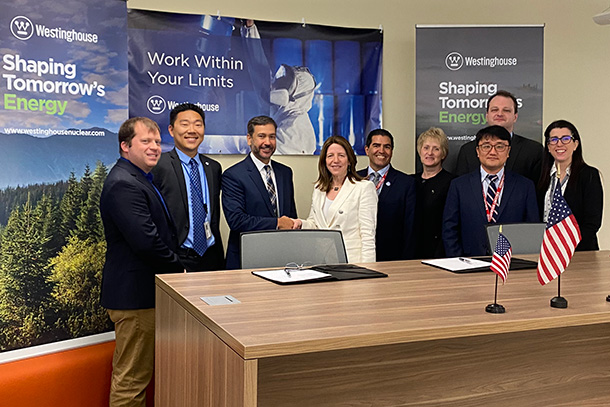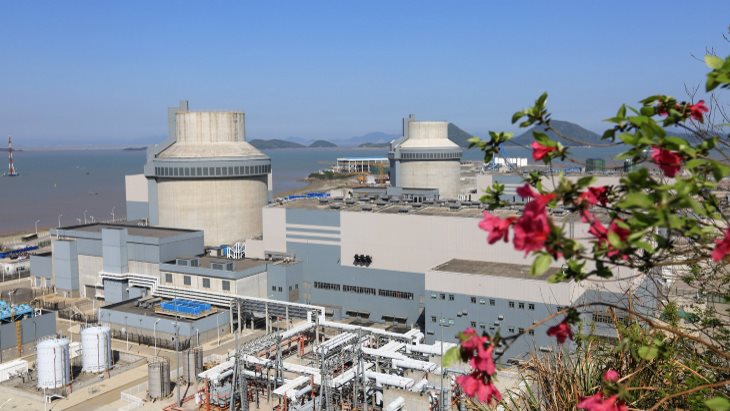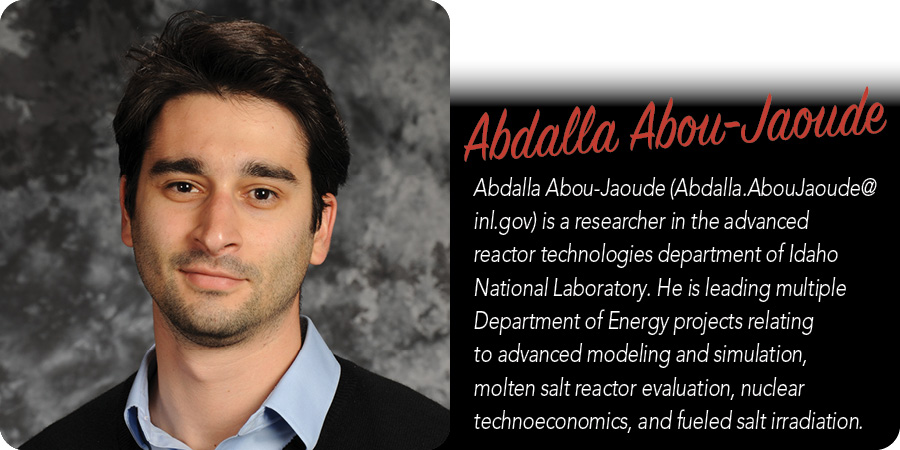University of Tokyo technical experts practice procedures for HEU packaging at the Yayoi Research Reactor, with help from Savannah River personnel. (Photo: University of Tokyo)
President Joe Biden and Prime Minister Fumio Kishida of Japan have announced the successful removal of more than 30 kilograms of high-enriched uranium from three Japanese sites to the United States. The news came in a May 23 statement from the Department of Energy’s National Nuclear Security Administration.
The world's first AP1000 reactors to enter operation, Sanmen units 1 and 2, in China. (Image: Westinghouse Inc.)
Westinghouse Electric Company and South Korea’s Hyundai Engineering & Construction have signed an agreement to “jointly participate in global AP1000 plant opportunities,” the Pennsylvania-based nuclear technology firm announced on May 24.
The first overseas NuScale Energy Exploration (E2) Center is planned for Romania. (Photo: NuScale)
Small modular reactor developer NuScale Power announced on Monday the signing of a memorandum of understanding with Romania’s Nuclearelectrica to conduct engineering studies, technical reviews, and licensing and permitting activities at a site in Doiceşti, Romania, selected as the preferred location for the deployment of a NuScale VOYGR power plant.
McMaster University, in Hamilton, Ontario, Canada. (Photo: McMaster University)
McMaster University, Ultra Safe Nuclear Corporation (USNC), and Global First Power (GFP) have embarked on a new partnership to study the feasibility of deploying a USNC Micro Modular Reactor (MMR) at McMaster University or an affiliated site. The three partners last week announced a memorandum of understanding that will support research on advanced reactor and small modular reactor technologies in support of Canada’s Net-Zero Emissions by 2050 goal.
The Pantex Plant in Texas (Photo: NNSA)
The National Nuclear Security Administration announced last week that it is canceling its November 2020 contract solicitation for management and operation of the Pantex Plant and Y-12 National Security Complex and terminating the contract award announced in November 2021 for the two sites. The NNSA intends to hold two new competitions for separate contracts to manage each site.
The Palisades nuclear power plant
Despite last month’s strong (and many might say overdue) expression of interest from Michigan Gov. Gretchen Whitmer in extending the operational life of the Palisades nuclear power plant via the Department of Energy’s new Civil Nuclear Credit Program, the facility’s 777-MWe pressurized water reactor was removed from service last Friday—11 days prior to its scheduled May 31 retirement date.

Representatives from Westinghouse and Penn State met at Westinghouse headquarters to sign a memorandum of understanding and enter a partnership focused on researching and developing microreactors. From left: Jason Beebe, director of the global transformation office at Westinghouse; Michael Valore, senior director of advance reactor commercialization, Westinghouse; Mike Shaqqo, senior vice president of advanced reactors, Westinghouse; Lora Weiss, senior vice president for research at Penn State; Jean Paul Allain, head of the Ken and Mary Alice Lindquist Department of Nuclear Engineering at Penn State; Geanie Umberger, associate vice president for research and director of industry research collaborations at Penn State; Saya Lee, assistant professor of nuclear engineering; Elia Merzari (back), associate professor of nuclear engineering; and Hilary Ruby, director of transformation for the Americas Operating Plant Services Business Unit at Westinghouse. (Photo: Westinghouse)
Artist’s rendering of USNC spacecraft using EmberCore. (Image: DIU)
The Defense Innovation Unit (DIU), a Department of Defense organization focused on swiftly putting commercial technology to use in the U.S. military, has awarded contracts for two nuclear technologies—compact fusion and radioisotope heat—for spacecraft that could carry a high-power payload and freely maneuver in cislunar space. The objective is to accelerate ground and flight testing and launch a successful orbital prototype demonstration of each approach in 2027.
The NNSA's ERICA initiative aims to provide resources to develop resiliency against climate-related obstacles like the 2021 shuttering of the Pantex
Plant due to the polar vortex. (Image: NNSA)
The Department of Energy’s National Nuclear Security Administration is establishing an Energy Resilient Infrastructure and Climate Adaptation (ERICA) initiative, which will help position it to deal with climate issues. In a recent press release, the NNSA noted that ERICA will help it to meet the requirements of federal legislature and executive orders, along with the DOE’s climate adaptation, energy resilience, and sustainability goals in support of the agency’s national security missions.
The initiative was outlined in President Biden’s fiscal year 2023 budget request for the DOE.
Conceptual site layout for the VTR, as shown in the Final EIS. (Image: DOE-NE)
The Versatile Test Reactor, a custom-designed sodium-cooled fast neutron spectrum test reactor, is one step closer to its goal of providing data to accelerate research, development, and demonstration of diverse advanced reactor designs. The Department of Energy released the Final Versatile Test Reactor Environmental Impact Statement (Final VTR EIS) on May 13, and 30 days after its anticipated May 20 publication in the Federal Register, the DOE will issue a Record of Decision on the project.
PSFC director Dennis Whyte (left) and CFS chief executive officer Bob Mumgaard in the test hall at MIT’s Plasma Science and Fusion Center. (Photo: Gretchen Ertl, CFS/MIT-PSFC)
The Massachusetts Institute of Technology’s Plasma Science and Fusion Center (PSFC) recently announced it will expand its involvement in fusion energy research and education under a new five-year agreement with Commonwealth Fusion Systems (CFS), a fusion energy company that got its start at MIT and is now building what it says will be the world’s first net-energy fusion machine—the demo-scale SPARC.
“CFS will build SPARC and develop a commercial fusion product, while MIT PSFC will focus on its core mission of cutting-edge research and education,” said PSFC director Dennis Whyte in describing the collaboration.



-2018.jpg)















